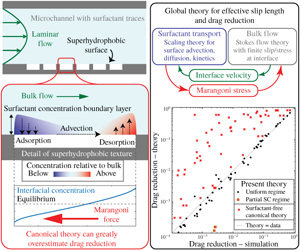Crossref Citations
This article has been cited by the following publications. This list is generated based on data provided by
Crossref.
Li, Hongyuan
Ji, SongSong
Tan, Xiangkui
Li, Zexiang
Xiang, Yaolei
Lv, Pengyu
and
Duan, Huiling
2020.
Effect of Reynolds number on drag reduction in turbulent boundary layer flow over liquid–gas interface.
Physics of Fluids,
Vol. 32,
Issue. 12,
Gao, Aiting
Butt, Hans-Jürgen
Steffen, Werner
and
Schönecker, Clarissa
2021.
Optical Manipulation of Liquids by Thermal Marangoni Flow along the Air–Water Interfaces of a Superhydrophobic Surface.
Langmuir,
Vol. 37,
Issue. 29,
p.
8677.
Li, Chunxi
Xiao, Han
Jiang, Rui
and
Ye, Xuemin
2021.
Effect of wall slip on vertical film drainage in presence of soluble surfactants.
Physics of Fluids,
Vol. 33,
Issue. 4,
Park, Hyungmin
Choi, Chang-Hwan
and
Kim, Chang-Jin
2021.
Superhydrophobic drag reduction in turbulent flows: a critical review.
Experiments in Fluids,
Vol. 62,
Issue. 11,
Papageorgiou, Demetrios T.
and
Tanveer, Saleh
2021.
Mathematical study of a system of multi-dimensional non-local evolution equations describing surfactant-laden two-fluid shear flows.
Proceedings of the Royal Society A: Mathematical, Physical and Engineering Sciences,
Vol. 477,
Issue. 2252,
Baier, Tobias
and
Hardt, Steffen
2021.
Influence of insoluble surfactants on shear flow over a surface in Cassie state at large Péclet numbers.
Journal of Fluid Mechanics,
Vol. 907,
Issue. ,
Mayer, Michael D.
and
Crowdy, Darren G.
2022.
Superhydrophobic surface immobilisation by insoluble surfactant.
Journal of Fluid Mechanics,
Vol. 949,
Issue. ,
Baier, Tobias
and
Hardt, Steffen
2022.
Shear flow over a surface containing a groove covered by an incompressible surfactant phase.
Journal of Fluid Mechanics,
Vol. 949,
Issue. ,
Bickel, Thomas
and
Detcheverry, François
2022.
Exact solutions for viscous Marangoni spreading.
Physical Review E,
Vol. 106,
Issue. 4,
Mcnair, Richard
Jensen, Oliver E.
and
Landel, Julien R.
2022.
Surfactant spreading in a two-dimensional cavity and emergent contact-line singularities.
Journal of Fluid Mechanics,
Vol. 930,
Issue. ,
Tomlinson, Samuel D.
and
Papageorgiou, Demetrios T.
2022.
Linear instability of lid- and pressure-driven flows in channels textured with longitudinal superhydrophobic grooves.
Journal of Fluid Mechanics,
Vol. 932,
Issue. ,
Bettaieb, Noura
Castagna, Marco
Passaggia, Pierre-Yves
Kourta, Azeddine
and
Mazellier, Nicolas
2022.
Prediction of resistance induced by surface complexity in lubricating layers: Application to superhydrophobic surfaces.
Physical Review Fluids,
Vol. 7,
Issue. 9,
Hardt, Steffen
and
McHale, Glen
2022.
Flow and Drop Transport Along Liquid-Infused Surfaces.
Annual Review of Fluid Mechanics,
Vol. 54,
Issue. 1,
p.
83.
Rahmani, H.
and
Taghavi, S.M.
2022.
Poiseuille flow of a Bingham fluid in a channel with a superhydrophobic groovy wall.
Journal of Fluid Mechanics,
Vol. 948,
Issue. ,
Kim, Minsu
Yoo, Seunghoon
Jeong, Hoon Eui
and
Kwak, Moon Kyu
2022.
Fabrication of Salvinia-inspired surfaces for hydrodynamic drag reduction by capillary-force-induced clustering.
Nature Communications,
Vol. 13,
Issue. 1,
Li, Ran
Wang, Zanshe
Chen, Meijuan
Li, Zhang
Luo, Xiaowei
Lu, Weizhen
and
Gu, Zhaolin
2022.
Fabrication and Characterization of Superhydrophobic Al-Based Surface Used for Finned-Tube Heat Exchangers.
Materials,
Vol. 15,
Issue. 9,
p.
3060.
Sundin, Johan
and
Bagheri, Shervin
2022.
Slip of submerged two-dimensional liquid-infused surfaces in the presence of surfactants.
Journal of Fluid Mechanics,
Vol. 950,
Issue. ,
Yu, Ning
Li, Zhaohui “Ray”
McClelland, Alexander
del Campo Melchor, Francisco Jose
Lee, Sun Youb
Lee, Jae Hwa
and
Kim, Chang-Jin “CJ”
2023.
Sustainability of the plastron on nano-grass-covered micro-trench superhydrophobic surfaces in high-speed flows of open water.
Journal of Fluid Mechanics,
Vol. 962,
Issue. ,
Tomlinson, Samuel D.
Peaudecerf, François J.
Temprano-Coleto, Fernando
Gibou, Frédéric
Luzzatto-Fegiz, Paolo
Jensen, Oliver E.
and
Landel, Julien R.
2023.
A model for slip and drag in turbulent flows over superhydrophobic surfaces with surfactant.
International Journal of Heat and Fluid Flow,
Vol. 103,
Issue. ,
p.
109171.
Rahnama Falavarjani, Afsoun
and
Salac, David
2023.
Modeling droplets with slippery interfaces.
Journal of Computational Physics,
Vol. 481,
Issue. ,
p.
112033.





